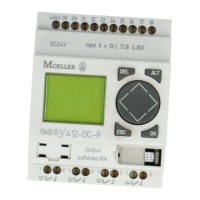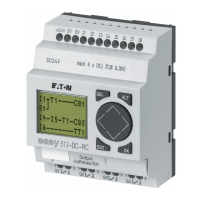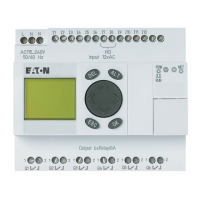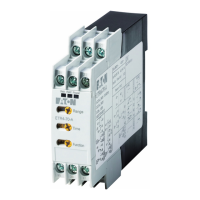Do you have a question about the Moeller EASY 618-AC-RC and is the answer not in the manual?
Introduces the "easy" control relay as a compact, user-friendly, low-cost solution for simple control applications.
Details the methods for mounting the "easy" control relay, either on a top-hat rail or a mounting plate.
Provides diagrams and specifications for connecting inputs for EASY 412-DC, EASY 412-AC, EASY 620-DC-TC, and EASY 618-AC-RC models.
Explains the operating buttons and cursor navigation used for programming and controlling the "easy" device.
Describes the buttons used for drawing circuit diagrams, including functions like deleting, toggling contacts, and adding connections.
Guides the user through the process of selecting the display language for the "easy" device upon initial startup.
Explains how to set the clock and week days for "easy" models that feature time functions.
Details the two operating modes, RUN and STOP, and discusses selectable startup behavior.
Lists and defines the various symbols used in "easy" circuit diagrams, including contacts, relays, and coils.
Provides a step-by-step example demonstrating how to draw and test a circuit diagram using the "easy" device's interface.
Describes different function relay types such as timing, counter, time switch, and analog comparator relays.
Illustrates how to incorporate and use specific function relays, like a timing relay with delay, in circuit diagrams.
Explains fundamental logic circuits such as negation, permanent contact, impulse relay, AND, OR, XOR, and latching circuits.
Presents general technical specifications including weight, operating temperature, protection class, and standards compliance.
Compares the technical features and specifications across different "easy" models like EASY 412, 618, and 620.
Introduces the "easy" control relay as a compact, user-friendly, low-cost solution for simple control applications.
Details the methods for mounting the "easy" control relay, either on a top-hat rail or a mounting plate.
Provides diagrams and specifications for connecting inputs for EASY 412-DC, EASY 412-AC, EASY 620-DC-TC, and EASY 618-AC-RC models.
Explains the operating buttons and cursor navigation used for programming and controlling the "easy" device.
Describes the buttons used for drawing circuit diagrams, including functions like deleting, toggling contacts, and adding connections.
Guides the user through the process of selecting the display language for the "easy" device upon initial startup.
Explains how to set the clock and week days for "easy" models that feature time functions.
Details the two operating modes, RUN and STOP, and discusses selectable startup behavior.
Lists and defines the various symbols used in "easy" circuit diagrams, including contacts, relays, and coils.
Provides a step-by-step example demonstrating how to draw and test a circuit diagram using the "easy" device's interface.
Describes different function relay types such as timing, counter, time switch, and analog comparator relays.
Illustrates how to incorporate and use specific function relays, like a timing relay with delay, in circuit diagrams.
Explains fundamental logic circuits such as negation, permanent contact, impulse relay, AND, OR, XOR, and latching circuits.
Presents general technical specifications including weight, operating temperature, protection class, and standards compliance.
Compares the technical features and specifications across different "easy" models like EASY 412, 618, and 620.
| Supply Voltage | 24 V AC/DC |
|---|---|
| Number of Digital Inputs | 6 |
| Number of Relay Outputs | 4 |
| Contact Configuration | SPDT |
| Switching Voltage | 250 V AC |
| Mounting Type | DIN rail |
| Real-time Clock | Yes |
| Protection Class | IP20 |
| Type | Logic Module |
| Operating Temperature | -25°C to +55°C |
| Mechanical Life | 10, 000, 000 cycles |
| Electrical Life | 100, 000 cycles |












